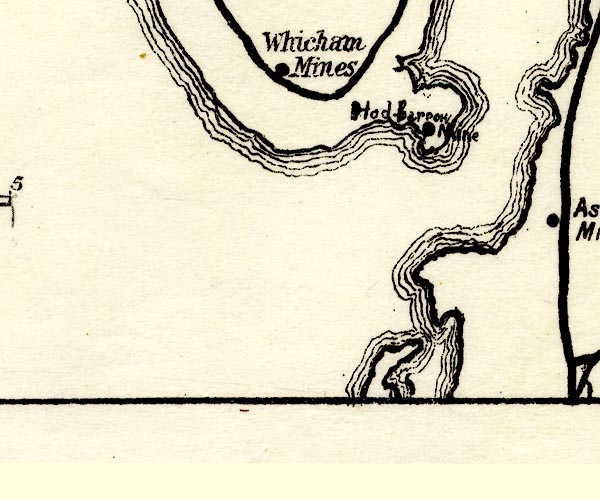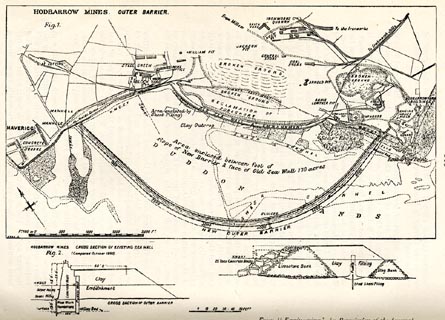




item:- haematite; iron ore
 goto source
goto sourcepage 141:- "In South Cumberland, where the limestone again emerges from beneath the rocks of the Permian Series, very rich deposits of haematite have been worked for many years at Hodbarrow, and"
 goto source
goto sourcepage 143:- "formerly (about 1885-7) at Whicham Mines, indeed the output of ore at the former is much larger than that of any other mine in Cumberland."
"The deposit of ore at Hodbarrow was first discovered by the occurrence of veins of ore in the shore, and the Earl of Lonsdale worked one of this veins for some time, but the quantity of ore obtained was not sufficiently encouraging. He therefore gave it up and granted a lease to the founders of the Company now working it, the Hodbarrow Mining Company. A shaft was sunk on the same vein, but as it was followed downwards it began to nip out. Boring was then commenced, and speedily proved the presence of a body of solid ore 17 fathoms in thickness. This occurred in 1856. Another large deposit was afterwards found by putting down a bore-hole at the bottom of a well for the purpose of obtaining a better supply of water for some of the Company's cottages. Afterwards a third and much larger deposit was found beneath the former and at a depth of 33 fathoms, the first deposit that was found being not more than 10 fathoms below the surface. These deposits of ore being on the shore, and dipping seaward, more bore-holes were put down below high water mark, and it was found that the ore had a considerable extension seaward. A sea-wall was then built to protect the mine from high tides, and to enable the miners to dig out as much of the ore as it was possible to do with safety. Finding that the ore still continued seaward, and that the rocky roof covering the shallowest deposit was scarcely sufficiently rigid to ensure safe working, another and far more extensive sea-wall was built, which enclosed an area of 170 acres of the margin of the Duddon Estuary. This gigantic work was completed in 1905, and the work of winning these vast masses of haematite ore will keep the workers employed for many years to come."
placename:- Hod Barrow Mine

PST2SD17.jpg
"Hod Barrow Mine"
mine symbol
item:- JandMN : 162.2
Image © see bottom of page
placename:- Hodbarrow Mines
 click to enlarge
click to enlargePST339.jpg
On p.144 of Mines and Mining in the English Lake District, by John Postlethwaite.
printed, upper left "HODBARROW MINE. OUTER BARRIER."
printed, bottom right "From "Engineering," by Permission of the Journal."
item:- JandMN : 162.41
Image © see bottom of page
placename:- Hodbarrow Point
 goto source
goto sourcePage 383:- "... a small promontory [Hodbarrow Point] on which an extensive red hematite iron mine is worked. A sea wall, about a mile long, has been constructed on the southern side of this promontory, to enable the mining to be carried on under the sea bed. There are depths of 20 feet (6m1) alongside this wall at high water springs, but it is fully exposed to the prevailing wind and the sea breaks over it with violence at times."
